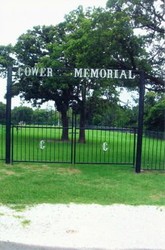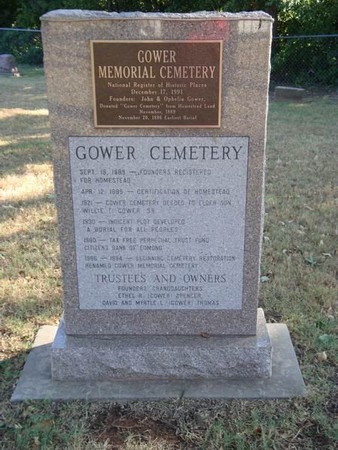Gower Cemetery
Introduction
Text-to-speech Audio
Images
Gates to Gower Memorial Cemetery (image from Find a Grave)

Marker on the history of the cemetery (image from Oklahoma Cemeteries)

Backstory and Context
Text-to-speech Audio
John Gower, a stonecutter, was born in Tennessee; he and his wife Ophelia, born in Louisiana, moved first to Kansas and then to Oklahoma, where they were among the original homesteaders in Oklahoma County. Ophelia served as a midwife to area families, and John donated part of his 160 acres to establish a cemetery for communities in the surrounding 56 square miles in November of 1889. Though Nonsey's church, school, and farmsteads no longer exist, the cemetery and associated records (collected in 1964) preserve at least part of the history of this African American town. From 1896-1933, Mt. Olive Baptist Church (on land donated by homesteader Augustus Reece) served the community, as did the Pleasant Grove School (on land donated by Mattie and Willie Kurley) from 1903 until sometime in the early 1940s. In the 1930s, the Gower's eldest son, Willie T. Gower, set aside an area in the cemetery for the burial of paupers, homeless, and indigents [1; 2].
Markers in Gower Cemetery range from
hand-lettered local sandstone and concrete to professionally made metal,
granite, and limestone markers, its earliest interment dating to November 20, 1896. Burials include at least six men who settled in the
community before 1890: John Gower, Anderson Harris, Henry B. Miller, William
O'Kelley, Isaac Samuels, and Reverend Walton Owens, the founder of Mt. Olive
Baptist Church. At least seven veterans of the "Colored Cavalry" and
"Colored Infantry" are buried on the grounds [2].
Cite This Entry
Marian, Sara. "Gower Cemetery." Clio: Your Guide to History. January 13, 2018. Accessed March 22, 2025. https://theclio.com/entry/47816
Sources
2. Meacham, Maryjo.
"Gower Cemetery." National Park Service, National Register of
Historic Places. October 5, 1991. Accessed October 13, 2017.

